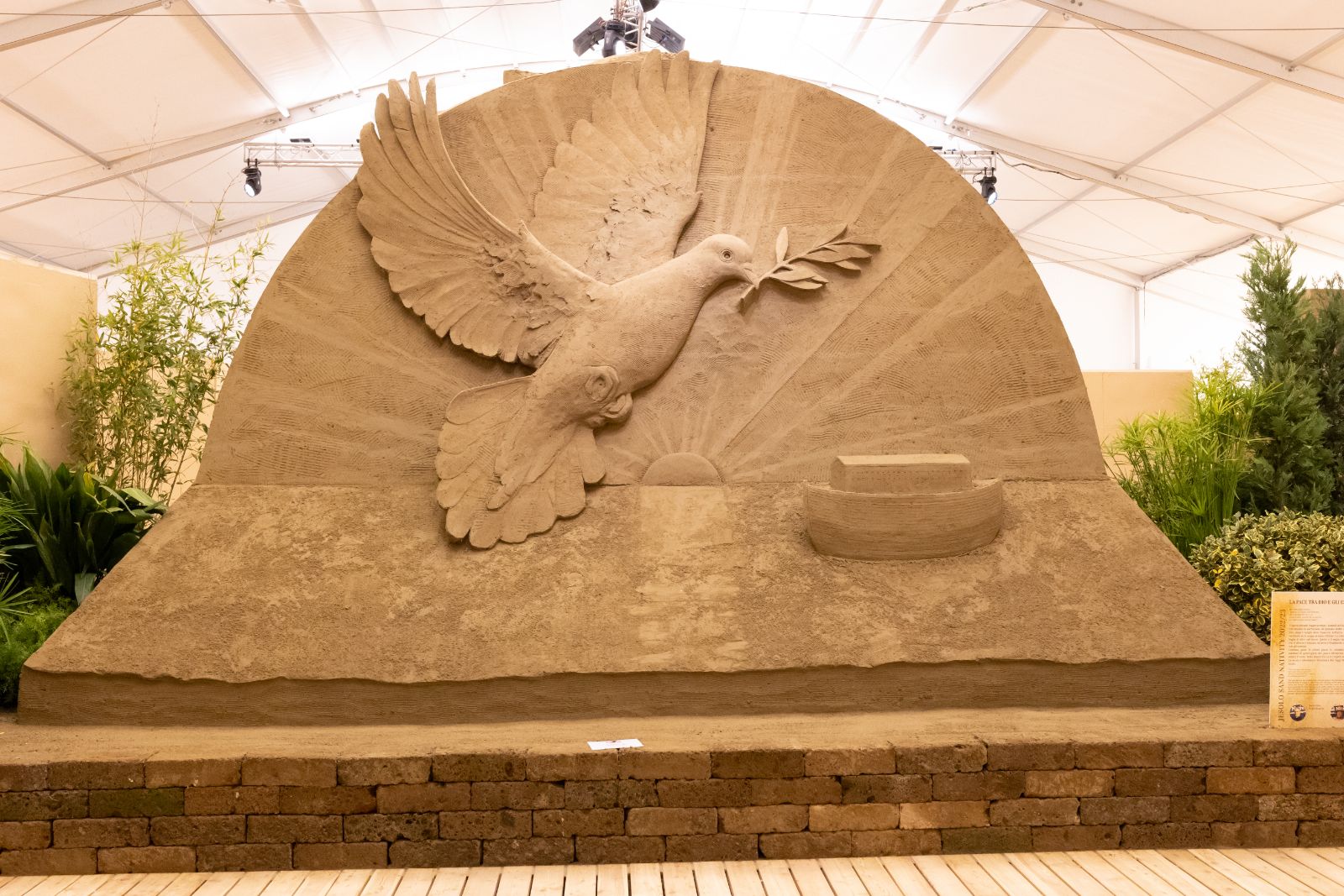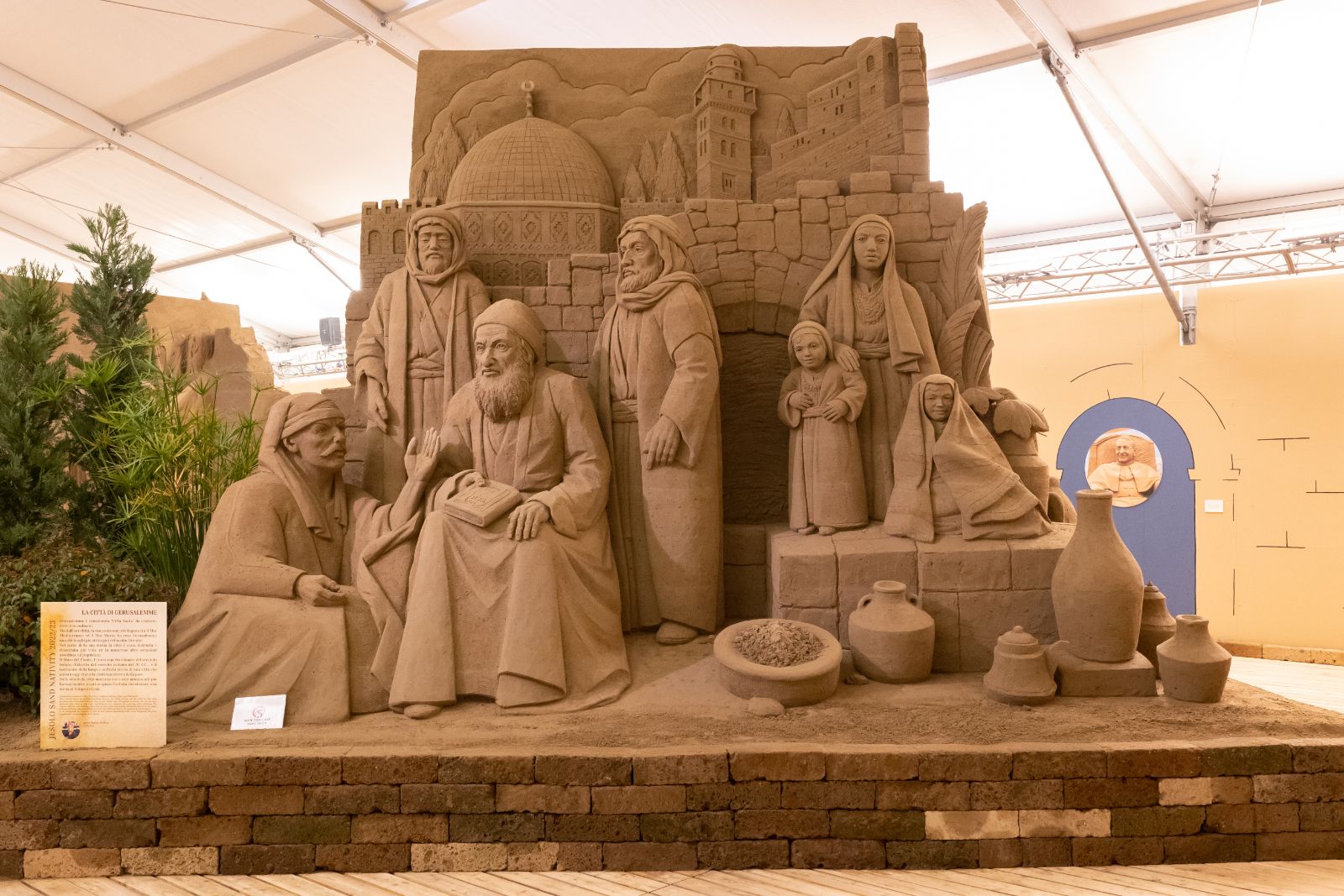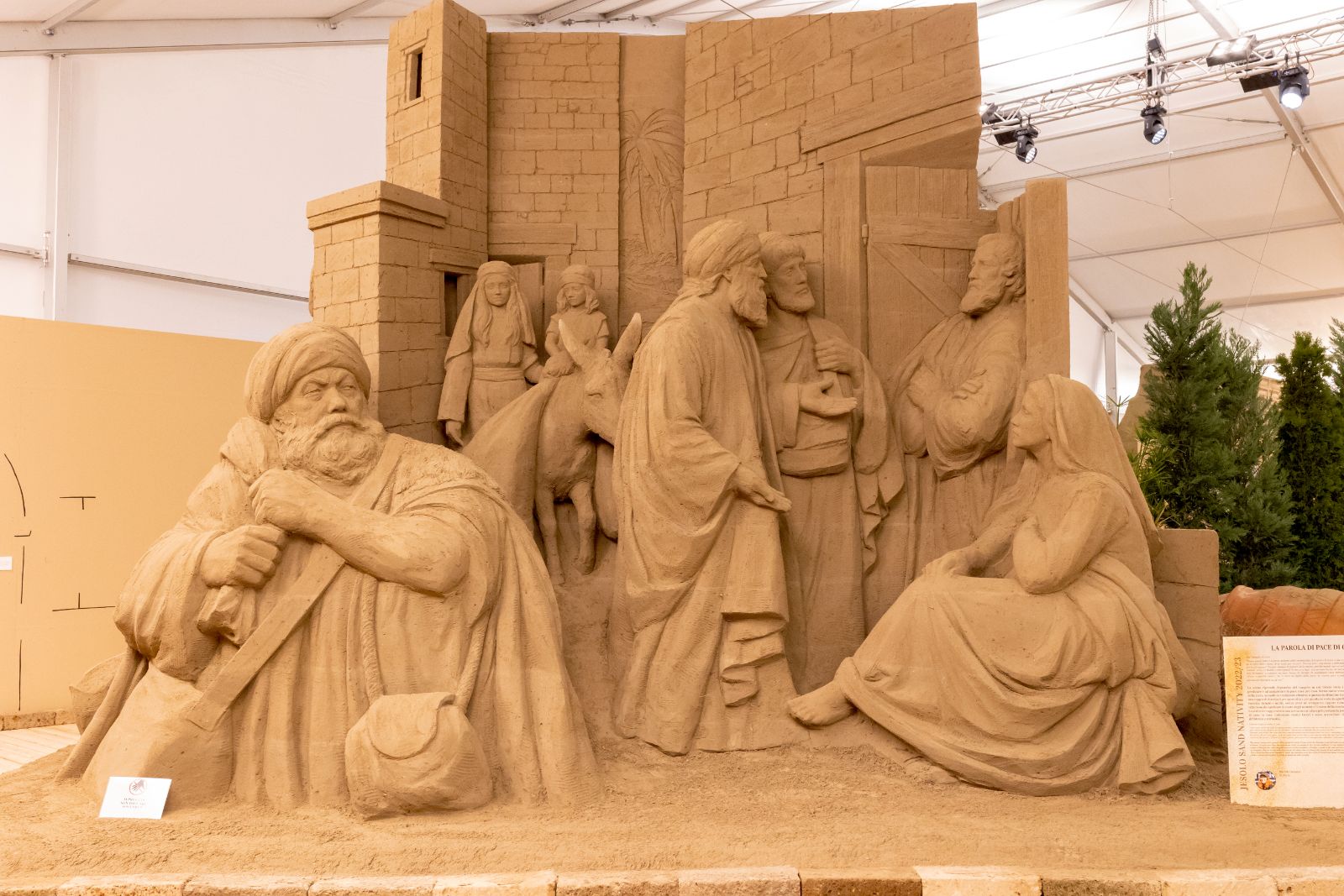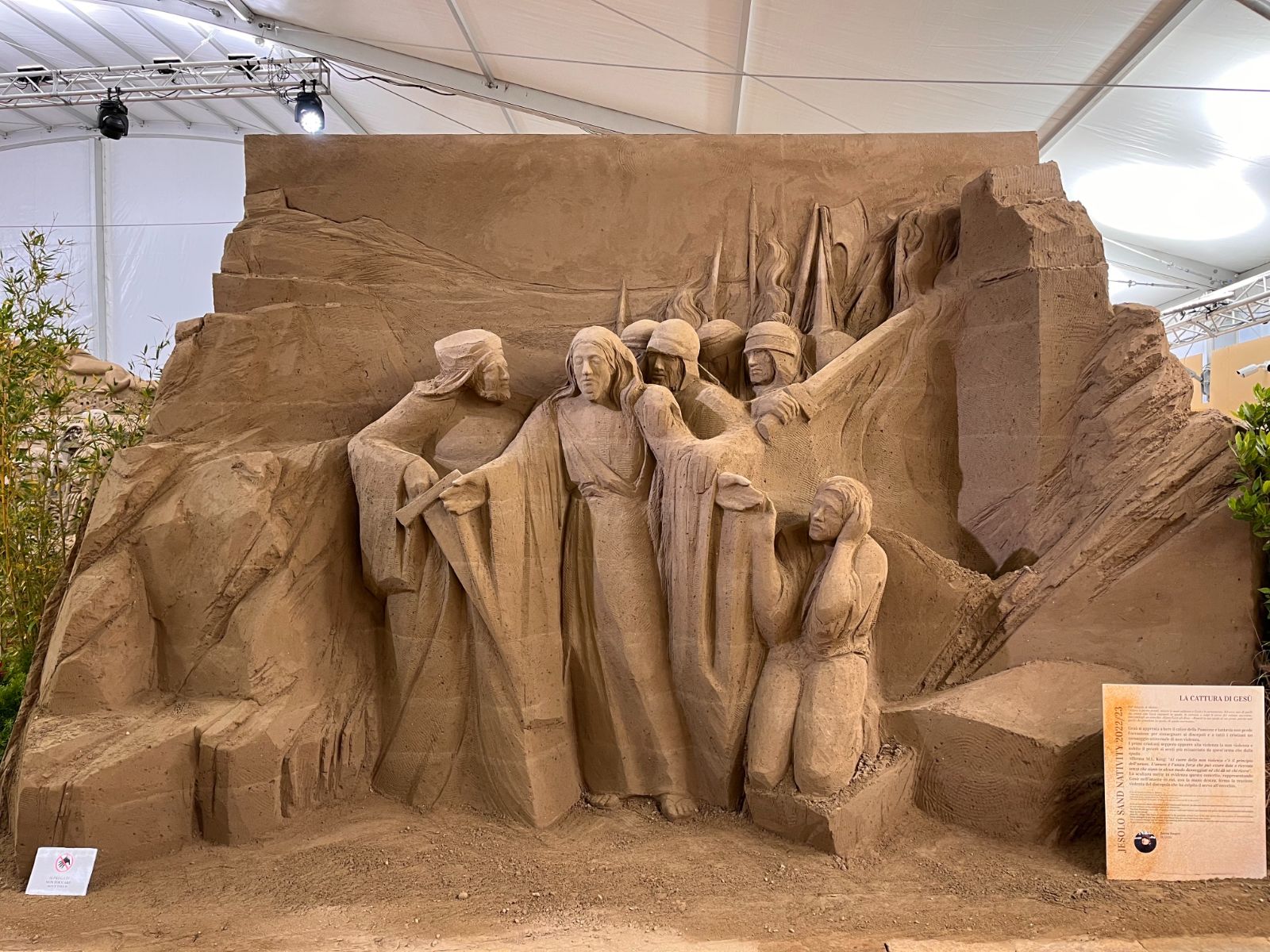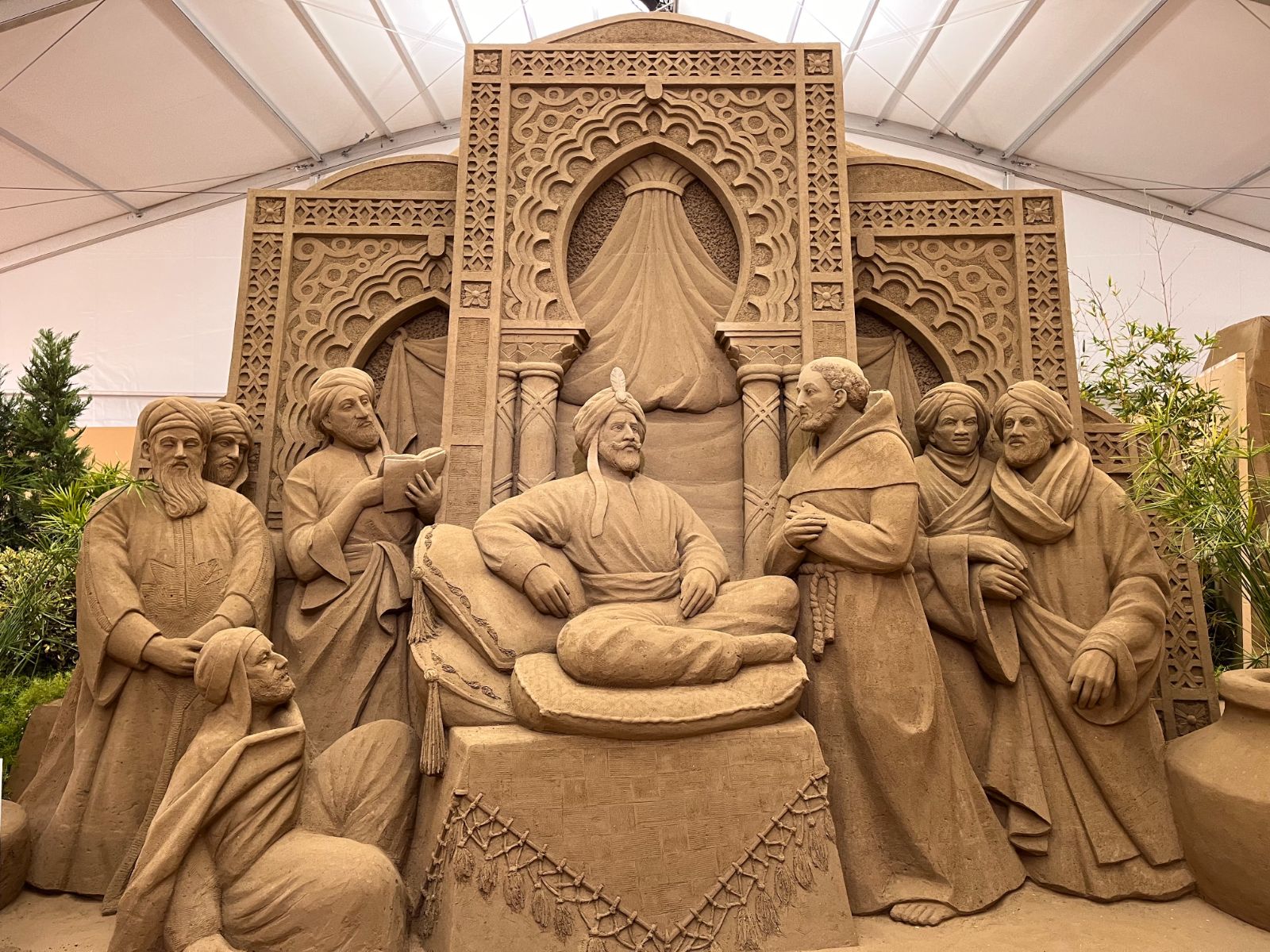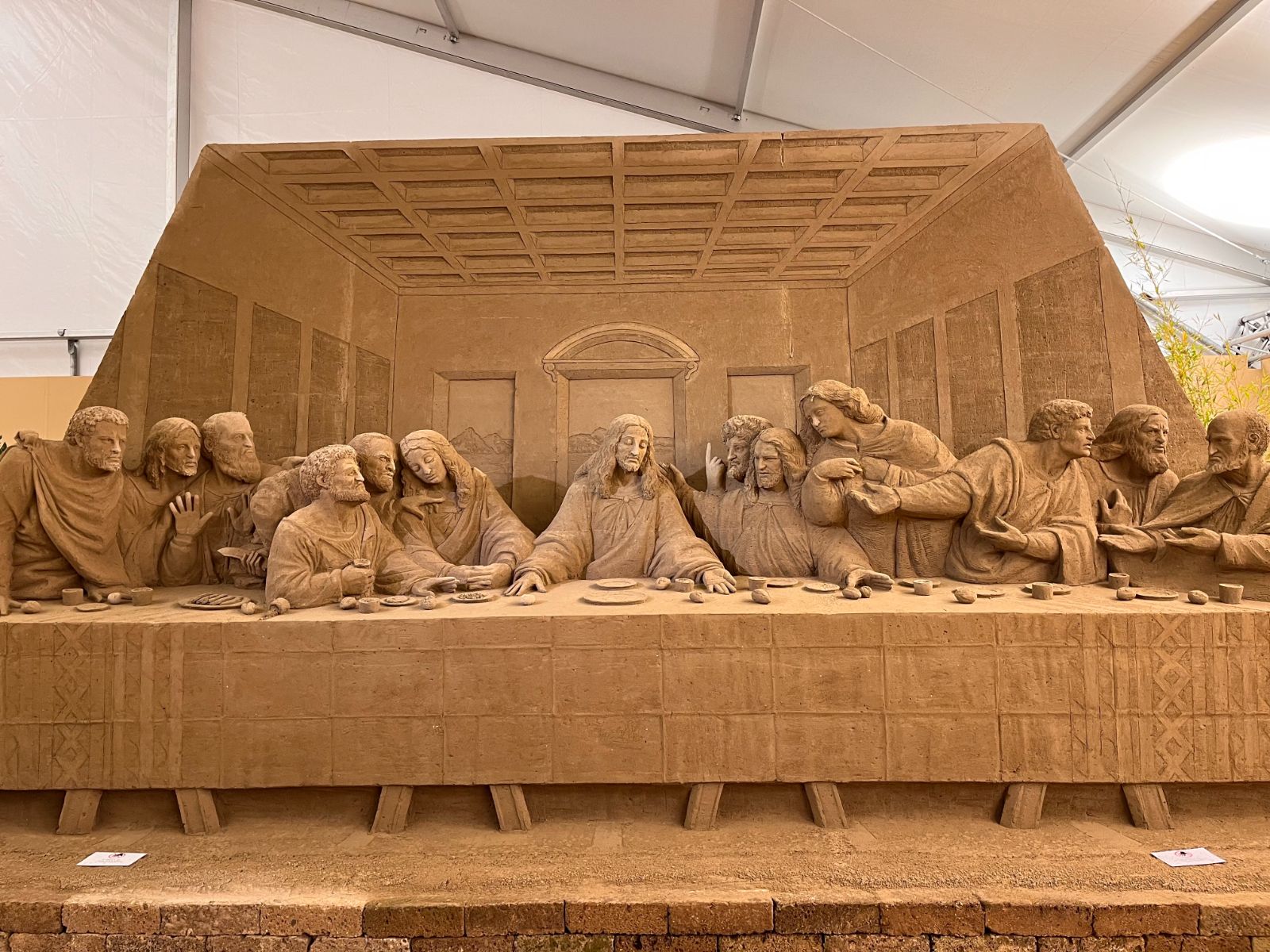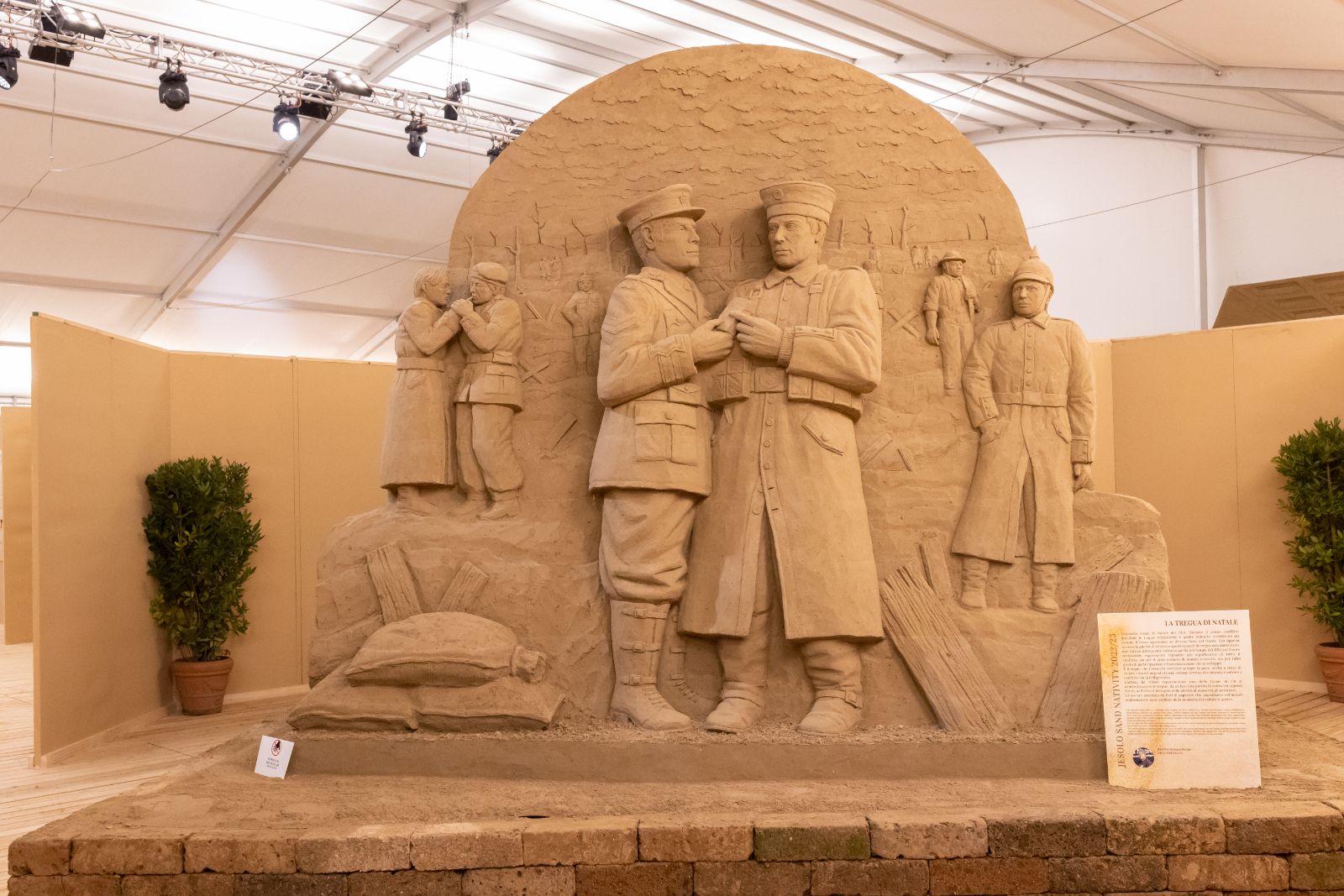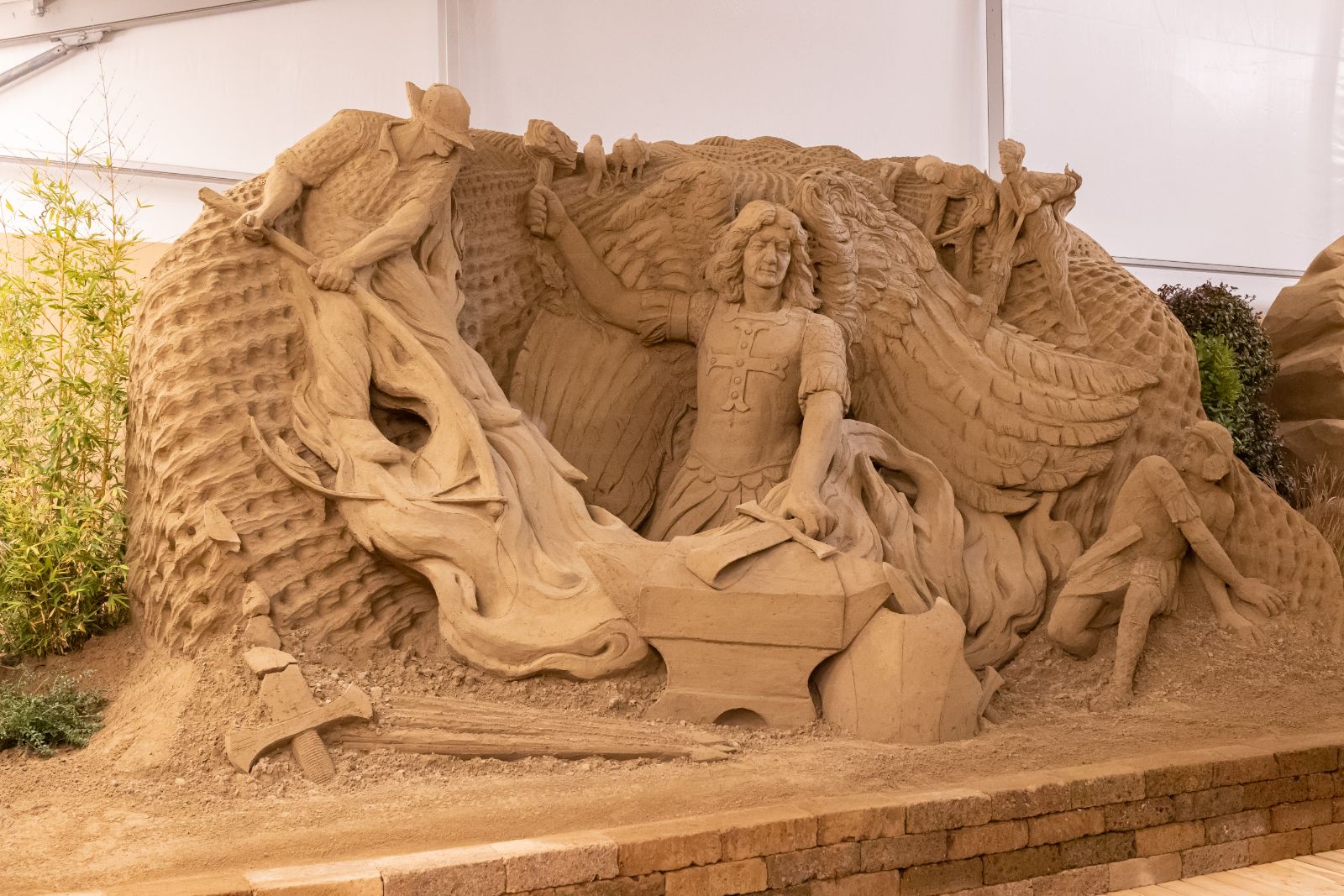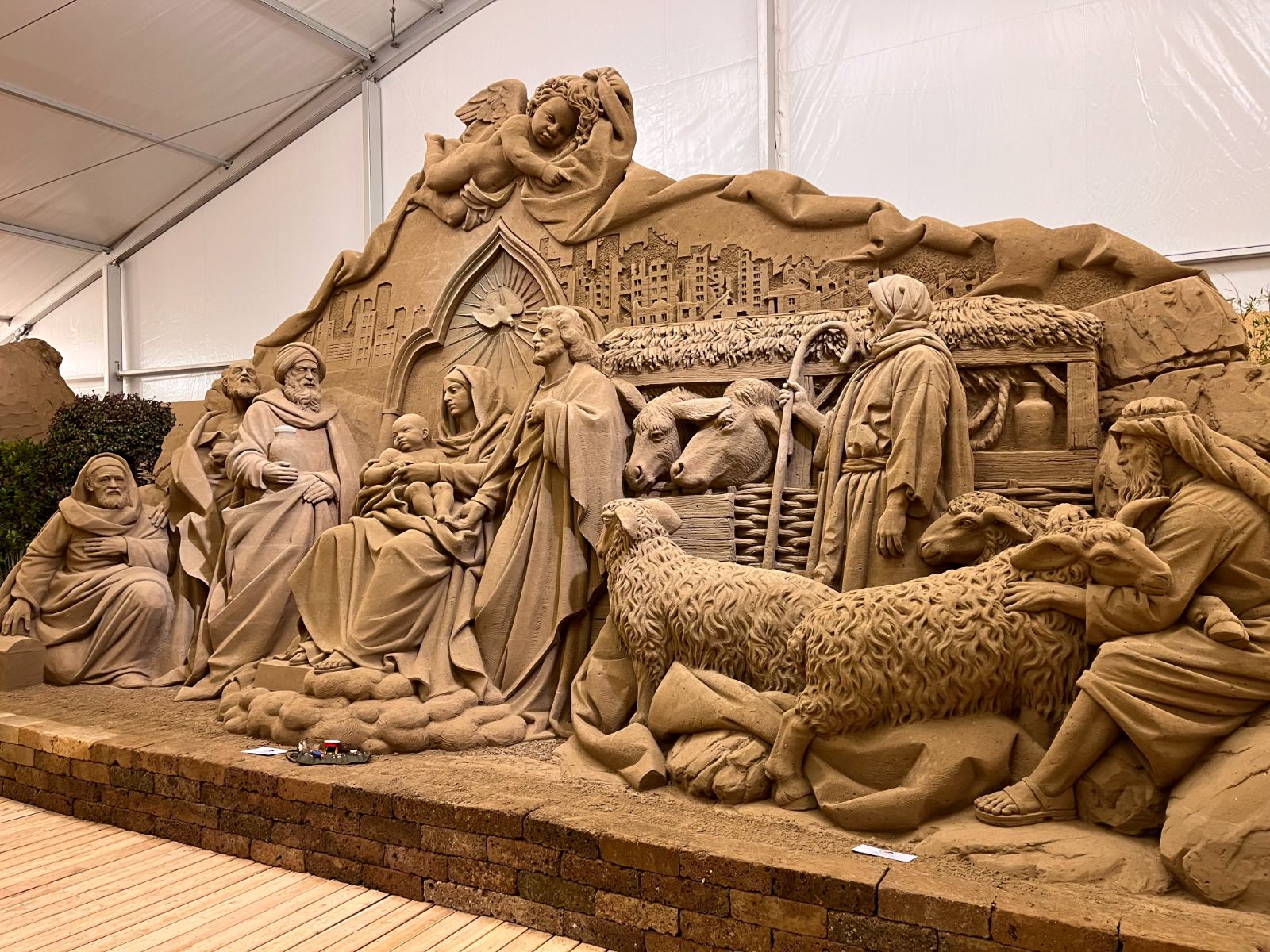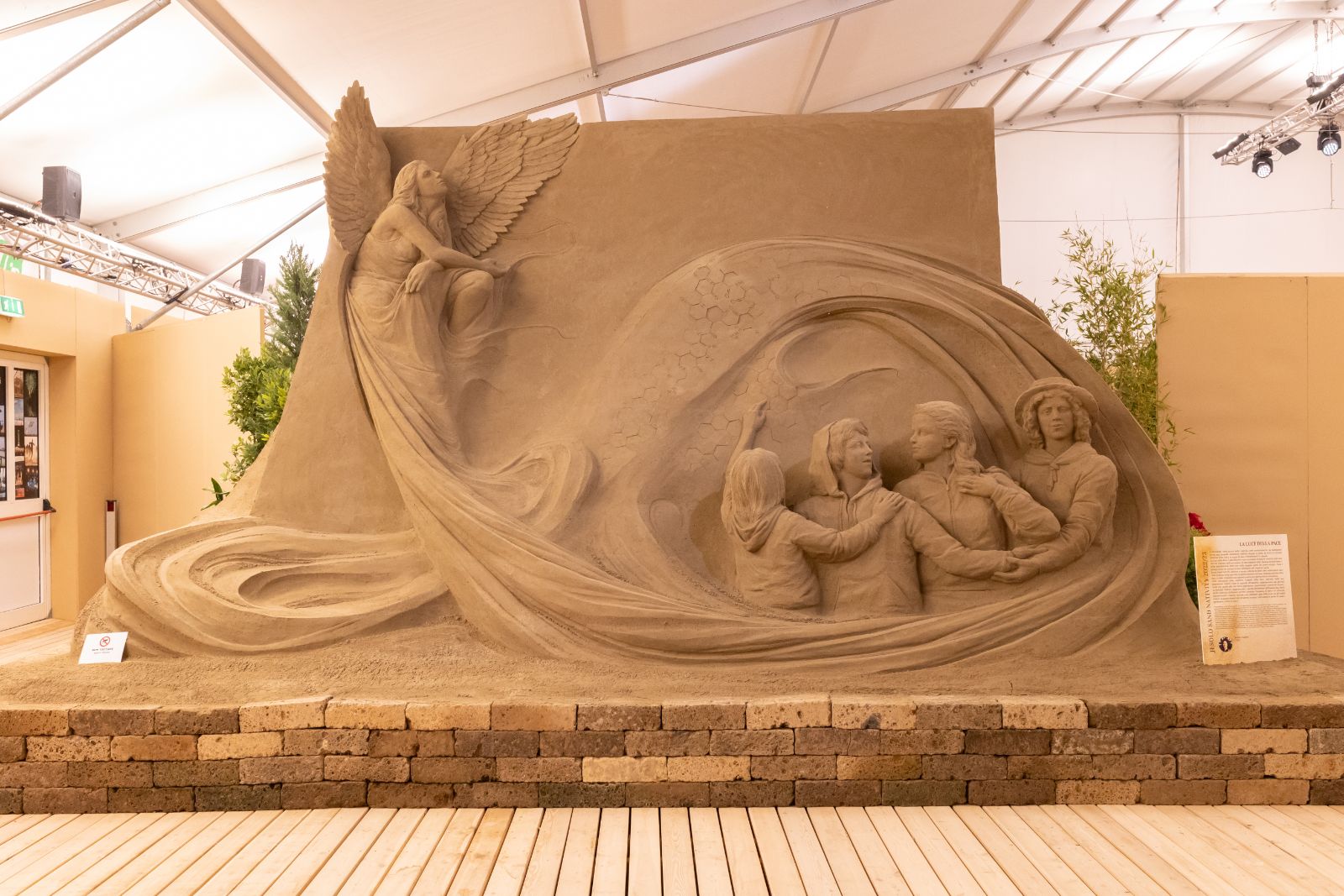
The Works
The theme chosen for the twentieth edition of Jesolo Sand Nativity 2022 is "Sculptures of Peace".
A journey of ten sculptures created by 15 international artists who discussed the theme of peace inspired by both evangelical episodes and historical facts. Against the backdrop of the tragic conflict in Ukraine which upsets the heart and conscience of Europe and which, as Pope Francis recalled, requires a strong collective will in favor of peace.
In this context, the visit to Jesolo of Monsignor Oleksandr Yazlovetskyi, auxiliary bishop of Kiev, who on 7 and 8 December will meet the Jesolo institutions and citizens, as well as the Ukrainian community, and will participate in the inauguration of the Sand Crib , reinforcing the message for the "building of peace" that the municipal administration strongly wanted in this edition.
Jesolo's message for Christmas is therefore enriched with meaning: the city is proposed not only as a destination for a pilgrimage (“…how the shepherds set out to reach Bethlehem, where Jesus was born in a cave.”), but also to visit a Peace meeting which has as its backdrop a unique Work of Art because it was sculpted in 1,000 tons of Dolomite sand by 15 international artists, among the best in the world.
The Sand Sculptures
Peace between God and living beings
Sculptors: Pedro Mira, Ferenc Monostori
from the Book of Genesis
"This is the sign of the covenant,
that I place between you and me
and every living thing that is with you,
for all future generations”
The work intends to represent the symbols of the covenant between God and man and refers in particular to the episode taken from the book of Genesis in which Noah, after the long months spent in the ark, lets out a dove to check if the waters have receded. The dove returns with a fresh olive leaf in its beak. That is the long-awaited sign: Noah understands that the flood has stopped, the earth is finally dry and God has made peace with men.
The artist places the dove of peace in the foreground, the absolute protagonist of this work which, placed at the entrance to the exhibition, immediately highlights its theme. In the background, the ark anxiously awaiting God's message. The scene is ideally illuminated by the rays of dawn, a sign of a new beginning.
The City of Jerusalem
Sculptress: Agnese Rudzite-Kirillova
Jerusalem is considered a "holy city" by Christians, Jews and Muslims.
Since ancient times, its privileged location between the Mediterranean Sea and the Dead Sea has made Jerusalem one of the most strategic places in the Middle East. Throughout its history the city has been destroyed and rebuilt several times and on numerous other occasions besieged and conquered.
The Wailing Wall, the only remaining relic of the second temple destroyed by the Roman army in 70 AD, bears witness to the long and painful history of a city that still lives today in the continuous search for peace.
In the background the modern city with its most famous monuments while in the foreground the artist reconstructs a scene at the time of Jesus.
Jesus' Word of Peace
Sculptress: Marielle Heessels
from the Gospel of Luke
“After these things the Lord appointed seventy-two others and sent them on ahead of him two by two into every town and place where he intended to go. He said to them: «The harvest is abundant, but the workers are few! So pray to the lord of the harvest to send out workers into his harvest! Go: behold, I am sending you as lambs among wolves; do not bring purse, bag or sandals and do not stop to greet anyone along the way. Whichever house you enter, first say: "Peace to this house!". If there be a son of peace, your peace will come upon him, otherwise it will return upon you."
The scene takes up the episode of the Gospel in which Christ sends his disciples to preach and proclaim peace house to house. Seventy-two were the nations of the earth, according to Jewish tradition; to this multitude Jesus sends only a couple of disciples for each city and in the guise of lambs: a small, weak and humble army, without weapons or arrogance, yet so strong and victorious as to change the hearts of men and the course of history.
The sculptress represents a scene in which the disciples carry the word of Christ from house to house; they wear ragged clothes and are surrounded by looks of distrust and curiosity.
The capture of Jesus
Sculptress: Helena Bangert
from the Gospel of Matthew
“Then they came forward, laid hands on Jesus and arrested him. And behold, one of those who were with Jesus took up his sword, drew it, and struck the servant of the high priest, cutting off his ear. Then Jesus said to him, "Put back your sword in his place, for all who take the sword will die by the sword."
Jesus is preparing to drink the cup of the Passion and yet he does not miss the opportunity to deliver a universal message of non-violence to the disciples and to all Christians.
The early Christians were able to oppose violence to non-violence and power immediately felt more threatened by this weapon than by the sword.
M.L. King says: “At the heart of nonviolence is the principle of love. Love is the only force that can be given or received without harming either the giver or the receiver in any way.”
The sculpture highlights this concept, representing Jesus in the instant in which, with his right hand, he stops the violent reaction of the disciple who hit the servant on the ear.
The meeting between Francis of Assisi and Islam
Sculptors: Hanneke Supply, Jakub Zimacek
The sculpture portrays the historic meeting between Francis of Assisi and the Sultan of Egypt al-Malik al-Kamil which took place in 1219. It is said that Francis undertook this journey to agree peace between the Crusaders and Muslims then at war for the holy city of Jerusalem .
Ten years after this meeting, witnessed by both Franciscan and Western scriptures as well as Arab-Muslim scriptures, a peace pact was stipulated for Jerusalem, one of the first historical peace agreements achieved through dialogue.
“Eight hundred years have passed since the meeting between Francis of Assisi and Malek al-Kamel. And it is the sincere desire for dialogue that countries and institutions are called upon in the first place, in order to guarantee the future of humanity.
Peace is a right inscribed in consciences and represents the deepest aspiration of every person, as soon as he looks beyond his present", these were the words of the President of the Republic Sergio Mattarella last October 4 in Assisi for the celebrations of Saint Francis .
The historic episode was also depicted by Giotto, "Francis meets the Sultan", in the basilica of San Francesco in Assisi.
Last supper
Sculptors: Susanne Ruseler, David Ducharme
from the Gospel of John
“Peace I leave with you, my peace I give you.
I do not give to you as the world gives.
Do not let your hearts be troubled and do not be afraid.
Jesus is seated with the disciples for the last supper, knowing that he has to face the path of the Cross.
To the disciples he announces the gift of peace. It is the last message that Christ delivers to his disciples and therefore to all Christians; it is the legacy that Jesus left to each of us and to future generations.
John Paul II on the 2002 World Day for Peace proclaimed in a speech that is as topical as ever: "There is no peace without justice and there is no justice without forgiveness. By the grace of God the world, in which the power of evil still seems to have the upper hand, will actually be transformed into a world in which the noblest yearnings of the human heart can be fulfilled, a world in which true peace will prevail.”
The sculptors were inspired by the famous fresco by Leonardo Da Vinci, located in the refectory of Santa Maria delle Grazie in Milan.
The Christmas truce
Sculptor: Baldrick Richard Buckle
The episode dates back to Christmas 1914. During the First World War, British and German troops established a spontaneous ceasefire on various front lines. Trench warfare had just begun and these episodes of unauthorized truce were not infrequent; however that of Christmas 1914 on the western front represented the most significant episode of the whole conflict both for the large number of men involved and for the high degree of participation and fraternization that developed.
It is the sign that humanity will always seek peace, even at the cost of violating the duties imposed by an earthly vision that intends to resolve conflicts with belligerence.
The artist wanted to represent one of the forms in which the truces took place: on the one hand a football match between opposite sides; on the opposite side the detail of the handshake between the opponents.
The scene is adorned with poppy flowers which, especially in the Anglo-Saxon world, signify the memory of the war dead.
The prophet Isaiah, messenger of peace
Sculptor: Enguerrand David
The sculpture wants to represent the peace between nations evoked by the great prophet Isaiah: "Swords will become ploughshares, spears will become sickles, nation will never lift up sword against nation". These words of the prophet Isaiah, who lived 700 years before Christ and handed down to us through the centuries, are carved into a wall at the entrance to the United Nations in New York; a message that comes from a distant time and still today reminds humanity that peace is “together a gift from above and the result of a shared commitment” (Pope Francis)
The sculptor wanted to plastically represent the evocative power of Isaiah's announcement: one of the warriors lays down his weapons first; he no longer wants to fight, kill, destroy; he wants another life for himself, to cultivate the land in peace.
The sword, an instrument of death, therefore becomes a tool for work, useful for obtaining food.
Nativity
Sculptors: Radovan Zivny, Wiaczeslaw Borecki, Vadim Gryadov
from the Gospel of Luke
“An angel of the Lord presented himself to the shepherds and the glory of the Lord enveloped them in light. They were seized with great fear, but the angel said to them: "Do not be afraid: behold, I announce to you a great joy, which will be of all the people: today, in the city of David, a Savior was born for you, who is Christ Gentleman. This is the sign for you: you will find a baby wrapped in swaddling clothes, lying in a manger". And immediately there appeared with the angel a multitude of the heavenly host, praising God and saying: "Glory to God in the highest, and on earth peace among men whom he loves".
The birth of Jesus is accompanied by the song of the angels who proclaim “peace on earth to men of good will”.
This sculpture, sculpted by three artists, places the traditional nativity scene at the center of the work. The angel placed at the top of the main scene protects the Holy Family with his right hand while with his left hand he conjures away the devastation of war.
The birth of Christ in a place of conflict and suffering is meant to be a message of hope so that peace will be re-established as soon as possible in the heart of Europe and in all countries oppressed by forgotten wars.
The Light of Peace
Sculptor: Michela Ciappini
In Bethlehem, in the grotto of the Nativity, an oil lamp has been burning perennially for many centuries, fed by the oil donated in turn by all the Christian nations of the earth, as a sign of peace and brotherhood among peoples.
The Light of Peace is an international initiative launched in Austria in the 1980s which consists of lighting a lamp from the flame of Bethlehem and distributing the light in most European countries, made possible with the collaboration of scout groups from all over Europe who bring the light of peace to their respective countries. Jesolo Sand Nativity has been participating in this activity for many years by hosting the light in the sculpture of the nativity; in this special edition, dedicated to the theme of peace, a special work has been created dedicated to this historic initiative.
In the intentions of the sculptress, the Angel of Peace, from the top of his celestial dimension, turns his gaze to humanity, represented by the young scouts who, thanks to their unifying force, are promoters and bearers of peace. The chemical formula represented is that of the hormone oxytocin, also known as the love molecule because it promotes empathy, care and interpersonal relationships. The author thus intends to eliminate any difference between human beings; as we are all endowed with this hormone, we are all able to love, forgive, create peace.


